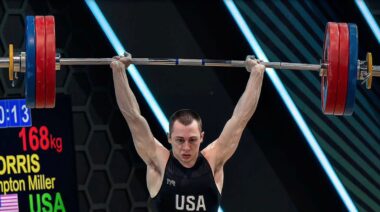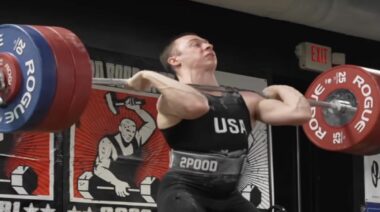It’s not uncommon to view exercise protocols through the same lens we view the persistent march forward of technology. Yesterday’s groundbreaking event is today’s antique. What must be kept in mind, however, is that the human body and its capacities do not change as fast as the digital world. So what worked in the distant past is still effective and can be employed to generate progress today.
It’s not uncommon to view exercise protocols through the same lens we view the persistent march forward of technology. Yesterday’s groundbreaking event is today’s antique. What must be kept in mind, however, is that the human body and its capacities do not change as fast as the digital world. So what worked in the distant past is still effective and can be employed to generate progress today.
The technique known as the split was the first attempt to lower the body under the bar for both snatching and cleaning. This began with the advent of the development of the snatch and clean, and their coincidence with the introduction of the Olympic bar, with its revolving sleeves. This all took place less than a century ago. The French and British were the first to refine the technique of splitting, and it was the technique du jour until the 1930’s, when the Germans began to develop squatting. After World War II, the superiority of the squat began to grow, and by the 1970’s, all of the world records were held by squat lifters.
But just because the squat proved to be more effective does not mean that the split was no longer effective at all. As a training lift, it still has merit.
Split Lifts and Injury Prevention
I started providing strength and conditioning training for female volleyball players in the early 1990’s. At that point, one of the major concerns was the prevalence of non-contact ACL tears among this population. I reasoned that one of the ways to inhibit these injuries was to develop stronger tendons and ligaments among my athletes. To do this, I had them performing squats—back, front, and overhead. I then began to add lunges for some of the girls who had ankle mobility problems.
In order to provide more variety in their training, I began to teach split snatching and split cleaning because the foot positioning was similar to that of many of the positions they assumed during the course of a volleyball game. I also reasoned that the heightened foot speed involved in splitting would aid in their foot movements while playing.
What I later figured out was that strengthening the ligaments through squatting, coupled with the braking under load required to catch the weight in power snatches, power cleans, and power jerks, was preventing ACL injuries. Furthermore, the split lifts provided opportunities to brake under load while balancing with one foot forward.
By alternating legs in the split, both legs had the opportunity to work under load. The result of this combination of factors is that I have coached female volleyball players for 24 years, and not one of them has suffered a non-contact ACL injury.
They also developed excellent foot speed, exceptional hitting power, explosive jumping ability, and improved running speed. Plus, they were playing closer to 100% at the end of a five-game match.
Taller Athletes Are Not Automatically Better
I’ve found that volleyball coaches are enamored of height, and don’t always see much beyond it.
One day, I watched one of my athletes, a 6’4” thirteen-year-old, walk around picking up plates off the floor. There was very little bending of the knees, just bending of the hips. Straightening the knees requires using the lesser mass of the quads to move the long femur. Straightening the hips employs the much greater mass of the glutes and hamstrings. Opting for the hip extension was the most ergogenic solution. This results in limited dorsiflexion, and hence a loss of extensibility in the Achilles tendon. This provides more of a setup for knee injury, along with an inability to use the quads for cushioning load.
Because volleyball involves so many young, very tall females with little muscle mass, teaching proper biomechanics through instruction in weight training was a solution to the knee-injury dilemma.
Splits in Programming for Athletes
During the regular season, the girls train three times per week. Power snatches and power cleans are performed twice per week, while split snatches and split cleans are done once a week, with legs alternating. During the tournament portion of the season, the girls train twice per week. Power snatches and power cleans are performed once a week, and split snatches and split cleans once a week.
The movements are performed with weights that can be performed with efficient technique at good speed levels. The attention of the coach should be directed so that these exercises are employed to improve athleticism and not solely to improve strength.
Here are more ways to prevent injury:
5 Injury Prevention Exercises To Build Bulletproof Athletes






